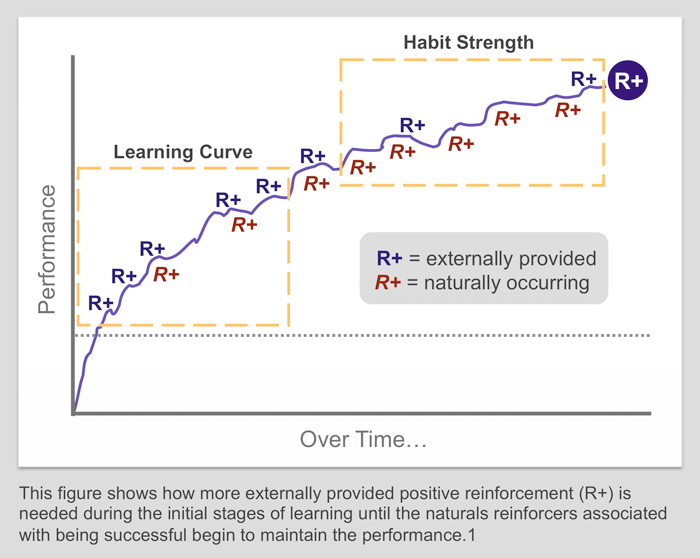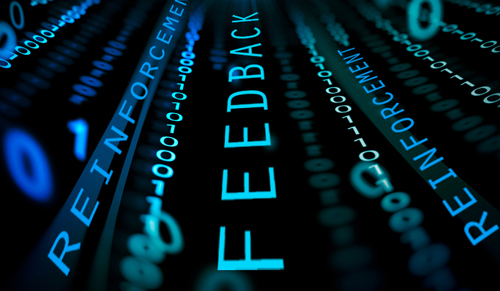Building Feedback and Natural Reinforcement into Software Applications
The launch of a new software application is more often met with muttering and sighs than with enthusiasm. If the new application is replacing an old one, users must not only learn the new application, they must unlearn old habits tied to the application being replaced. The unlearning occurs through extinction and typically has emotional side effects. Anyone who skipped the 2007 release of Microsoft Office and made the leap from Office 2003 to Office 2010 has experienced this directly. Fluent habits that had worked for years abruptly began leading to dead ends and frustration.
 Some organizations bite the bullet by merely removing the opportunity to use the old application, launching the new one, and then hoping for the best as users make the transition. Others provide some basic awareness training for the new application. (How to design effective and efficient software training is a topic for another article.) Although rarely done, feedback and reinforcement can and should be provided by organizations to recognize and reinforce using and building expertise with the new software. This external feedback and positive reinforcement during skill acquisition is critical for decreasing the time to performance fluency, building software-use habits last, and appropriately acknowledging the extra time and effort caused by the software change. This approach will also prompt positive conversations about using the software while limiting the potential for negative gossip.
Some organizations bite the bullet by merely removing the opportunity to use the old application, launching the new one, and then hoping for the best as users make the transition. Others provide some basic awareness training for the new application. (How to design effective and efficient software training is a topic for another article.) Although rarely done, feedback and reinforcement can and should be provided by organizations to recognize and reinforce using and building expertise with the new software. This external feedback and positive reinforcement during skill acquisition is critical for decreasing the time to performance fluency, building software-use habits last, and appropriately acknowledging the extra time and effort caused by the software change. This approach will also prompt positive conversations about using the software while limiting the potential for negative gossip.
Building frequent PICs (positive, immediate, and certain consequences) into a software application can transform routine work into something more enjoyable or even fun. Video game designers, the virtuosos of frequent feedback and positive reinforcement, have demonstrated for years that people will demonstrate extraordinary Discretionary Effort™ doing what on the surface might seem like a mindless activity.
The following sets of questions were developed to help you think through how and where you would most benefit from building feedback and positive reinforcement into your software applications.
 What’s the Goal of Adding Feedback and Reinforcement?
What’s the Goal of Adding Feedback and Reinforcement?
- Improve accuracy – What are the greatest opportunities for user error?
- Mitigate response cost – What actions or tasks will be the most difficult for users? The difficulty could be due to the level of effort required, the technical complexity of the task, or the precision required. Feedback and reinforcement can help mitigate the negative effects of high response cost.
- Improve compliance – What actions or tasks are critical for customer service, regulatory compliance, or internal process compliance and are not being consistently performed?
- Increase pace – What tasks will be repeated many times in succession?
- Improve engagement and job satisfaction – What would the users enjoy knowing about their performance and what they are accomplishing?
What Will Trigger the Feedback and Reinforcement?
 Typically, you will arrange for the application to provide feedback and reinforcement based on an action or series of actions performed by the user, ranging from a single action to the completion of multiple tasks. You also might provide feedback and reinforcement based on other features of how they are using the application such as the validity of the data entered or the volume of tasks completed.
Typically, you will arrange for the application to provide feedback and reinforcement based on an action or series of actions performed by the user, ranging from a single action to the completion of multiple tasks. You also might provide feedback and reinforcement based on other features of how they are using the application such as the validity of the data entered or the volume of tasks completed.
Could be triggered based on the following levels of events:
- Individual actions – entering text in a field, selecting a response option, etc. (e.g., entering a service code or identifying a hospital as in or out of network)
- Set of actions – fulfilling the requirements of a window or screen or a set of windows/screens (e.g., updating physical medicine visit calendar or completing DME window)
- Task – a single task such as processing a claim
- Multiple tasks – a series of tasks in a process or a repetition of the task with a series of inputs (e.g., processing multiple claims)
Could be triggered based on meeting one or more of the following criteria:
- Accuracy – the validity of data entered
- Compliance – compliance to a rule or set of rules (e.g., all required fields completed and response options selected based on situation, task completed within defined time period, notes screen accessed prior to performing some function)
- Speed – the speed of task completion
- Productivity – the volume of task completion
 How Can Feedback and Reinforcement be built into Software Applications?
How Can Feedback and Reinforcement be built into Software Applications?
Decrease Negative Consequences
- Reduce response cost (time and effort of user) – make the GUI and functionality intuitive through simplicity, consistency, functional use of visual cues to prompt actions, and logical organization of fields, data displays, and functionality; minimize multiple requests for the same information; minimize wait time between functions; minimize use of modal dialogue boxes and alerts; include efficient search functionality; etc.
- Reduce opportunity for error – provide easy access to current information when it’s needed to perform an action, allow actions to be undone or changed, etc.
Increase Feedback and Positive Consequences
- Acknowledge actions – use of visual cues to acknowledge user actions
- Provide information – provide relevant information as soon as it is meaningful and useful
How Will the Information be Viewed?
- Non-modal window – a pop-up window that doesn’t require a user response
- Modal window – a pop-up window that requires a user response before the user can do anything else in the application (use with caution to avoid unintended negative consequences such as increasing response cost)
- Current window – a change (visual cue or text) to the current window
- Manually accessed window – the addition of or change to a separate, manually accessed window


